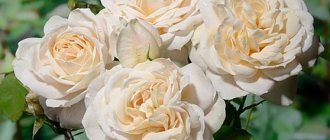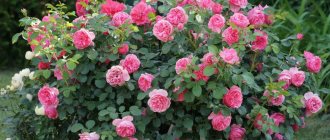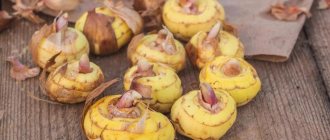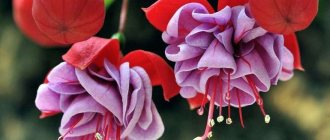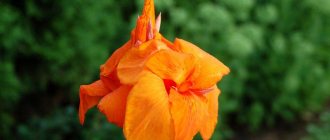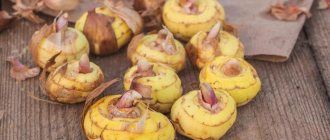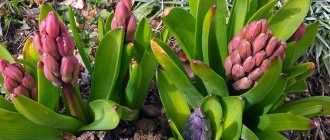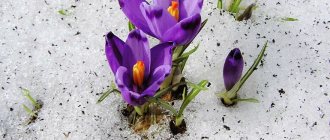Caring for dahlias is an important issue for many gardeners. That is why this issue will be discussed in the article.
One of the most beautiful, bright and long-blooming flowers. Here is a brief description of perennial garden plants - dahlias. This flower has 42 species and belongs to the Asteraceae family or, as they are also called, Asteraceae. Its main advantage is that it blooms from May - July until frost. But you need to be able to plant them correctly and care for them, which is what information will be provided in this article.
What a perennial dahlia looks like: photo
In common or colloquial conversation, the name of a flower is attributed to the masculine gender, but in the professional sphere it is associated, on the contrary, with the feminine class. That is, the ending “a” is added.
Interesting facts from history:
- The flower has two roots of origin. More precisely, its naming. The Latin version of "dalia" comes from the surname of the Swedish botanist Anders Dahl. But the Russian variation was obtained in honor of the geographer Johann Georgi from St. Petersburg.
- This type of flower was first discovered in Mexico back in the 15th century. Then the plant was used as food and helped against many diseases. Its most common use is in the treatment of epilepsy.
Biological description:
- Root system. In dahlias it is represented by root tubers or root cones. While the stem dies every year, the root tubers can live for several years. Therefore, the plant was given the status of a perennial flower. They have a thickened and fleshy structure. They do not have eyes that will give rise to shoots. That's why the next part is so important.
- Root collar . This is the transition from tubers to plant stems. In this place, the outer part dies off and the rudiments of future shoots appear. Therefore, this is the most important part of the plant.
Important! When digging in autumn, you need to be extremely careful with this part; it must not be cut off or damaged. Otherwise, the plant will simply die completely.
- Stem. They are straight and branched, and can be smooth or rough (depending on the species). The thickness ranges from 3 to 6 cm, and it is hollow inside. Therefore, heavy inflorescences and intense wind can easily break the plant. The height of the bush depends on the variety: Dwarf dahlias grow only 0.7-1 m in height
- Medium-sized ones can reach approximately 1.5 m
- But tall ones reach 2-2.5 m
Variety:
- Simple dahlias. Their flower stalks have one line of petals, up to 10 cm in diameter. The height of the plant reaches 45-60 cm.
Simple dahlias
- Anemoneaceae . They already have several layers of petals, in the middle of which their shape is slightly elongated and tubular. The diameter of the inflorescence is the same, but the height of the ground part can reach up to 90 cm.
Anemone species
- Chrysanthemum-shaped . The size of the plant is the same as that of anemone dahlias. The petals of the plant have a reed-like shape, twisted into a tube. Color can range from white to red, including yellow and pink tints. Reminds me of chrysanthemums.
- Collared. The size of the bush is slightly larger - 75-125 cm. The inflorescences really have the shape of a collar. The outermost flowers have one row of petals of the same color. But the core has a different color with short and twisted petals.
Collared dahlias
- Peony-shaped. The inflorescences are slightly larger - 12-15 cm, with straight and flat petals along the edges of the flower and with a tubular, inner core. The height of the plant itself is the same as the previous type.
- Decorative. The largest species, since the inflorescences can be from 8 to 23 cm, and the height reaches 60 cm.
- Globular. The name speaks for itself - the inflorescences resemble a ball in shape, but sometimes they can be slightly flattened with double and tubular petals. The dimensions of the flower are 8-15 cm, the ground part is 90-120 cm.
Globular dahlia
- Pompons. They have double inflorescences of a round shape, the diameter of which is above 5 cm. A distinctive feature is twisted marginal flowers with a blunt and rounded end. Bush height up to 120 cm.
Pompom look
- Cactus dahlias. The inflorescences also have a double shape, with a diameter of 8-25 cm. The height of the stem reaches 150 cm. The distinguishing feature is narrow and pointed, twisted marginal flowers.
cactus species
- Semi-cactus . The dimensions of the plant are the same as in the cactus version. But the marginal petals are slightly curled away from the middle of the core. Nymphaeaceae . Very similar to water lilies. The inflorescences are double and regular in shape. Their diameter ranges from 7 to 20 cm, the height of the bush can be up to 135 cm.
Important! There are even black dahlias. Or rather, red and black. The merit of this color is that the plant contains a large amount of pigment - anthocyanin. It is this that saturates the plant in red, blue or purple color. And a large percentage of it creates a black tint.
Varieties
Needle dahlias
The number of varieties is so large that dahlias are divided into groups according to the shape of the flowers. Plants from the “minion” group are varieties with simple flowers.
Among them there are miniature forms with a bush height of less than 30 cm. Peony-shaped and anemone-shaped dahlias, together with collared dahlias, belong to the group of semi-double ones.
Today there are several tens of thousands of varieties of this perennial plant.
Terry dahlias do not have a core - it consists entirely of flower tongues. In cactus (needle-shaped) varieties, these tongues are long and pointed. In spherical, pompom-shaped and nymphal dahlias, the tongues are folded like a spoon and give the flower a neat ball shape.
When to start preparing the roots of perennial dahlias for planting after winter: planting dates
Dahlias are heat-loving plants. They are terribly afraid of drafts. By the way, take this into account when choosing a landing site. They need to be taken out of a cellar or other storage place when the earth is already sufficiently saturated with heat.
Consider your latitude:
- in the southern regions, tubers need to be prepared from the end of April
- in a mixed natural zone this period falls in the month of May
- but in the northern area it’s the beginning of June
Important! The air temperature should not be lower than 18-20°C.
Remember
- When to plant dahlias depends on the region . In mid-latitudes it is the beginning of June. At this time the frost ends. In the south at the end of April. By this time the soil is sufficiently warmed up.
- Tall varieties of dahlias must be tied up . The stems of the plant are hollow. They break easily during gusts of wind. When planting in the soil, drive sticks next to the holes and tie the bushes as they grow.
- If the stem is broken, it must be straightened immediately and a tight bandage applied to the broken area.
- After digging, disinfect the tubers . Planting material is better preserved.
How to select the right dahlia tubers for planting?
There is nothing complicated or supernatural in this process. It is necessary to remove dried tubers and remove damaged areas by cutting. The main thing is to treat the places of “trauma”. Most often, ordinary brilliant green, a weak solution of potassium permanganate, or ash are used. The last material should be carefully rubbed over the required area.
Tuber processing
- It’s better to place all the tubers in a weak solution of potassium permanganate for 30 minutes to 1 hour.
- Experienced gardeners have noted another method - an ash solution. You need to pour ¼ bucket of ash with cold water and leave for a day. Top water and use to disinfect tubers. They need to be placed for 2-3 hours.
- Those tubers that do not contain growth buds also require special attention. They are attached to a common center with thin roots. After planting in flower beds they rot. Therefore, trim them without regret; it will not cause damage to the bush.
Soil preparation
Dahlias prefer moisture-absorbing, structured soil, which at the same time has high water permeability. Wrong choice of soil very often causes the death of dahlias. You can improve the soil structure using organic additives:
- humus;
- fresh or rotted manure;
- peat;
- straw cutting;
- compost;
- turf soil and other materials that are easily decomposed in the soil.
In heavy, clayey soils, to improve water permeability, add:
- coarse river sand;
- gravel;
- ash (peat or coal);
- peat;
- coal slag (fine, sifted and washed).
If the site is dominated by sandy soil that does not retain water well and is easily eroded, you can add to it:
- vermiculite or perlite;
- peat;
- clay and other materials that help retain moisture.
Tip: there is no need to clear the soil of gravel or small stones; such additives in any type of soil will not interfere with the normal development of dahlias.
Dahlias are not too picky about soil acidity and can tolerate too much or too little of it, but they show best results in slightly acidic or neutral soils. But highly alkaline soils inhibit their development and growth. Before planting dahlias, you can conduct an acidity analysis in order to then bring it to the desired levels:
- when the pH value is 4-5, slaked lime is added to the soil (30-100 kg per 100 sq. m.);
- at a Ph level of 8 and above, the soil is acidified by adding peat.
The place where dahlias will grow is plowed deeply in the fall - 30-35 cm. Then, 2-3 weeks before planting the flowers, the soil is dug or plowed again, paying special attention to harrowing and loosening.
How to properly divide and process dahlia tubers for planting?
After small shoots have appeared, you need to start dividing the roots. Some gardeners carry out this operation in the fall. But practice shows that in this case, the damage to planting material increases several times due to rotting or drying out.
- The root, so-called “mother’s nest” must be divided into separate segments with a sharp knife. Each of them should have a root collar and 1-2 growth buds.
- There is no need to leave extra buds. Otherwise, the planting will give all its juices to the development of extra stems, and not to the creation of inflorescences. Then the flowers will turn out small and weak.
Important! If there are a lot of buds on one tuber, then it is better to cut the root in half. The main thing is to equally divide the root collar. In this case, you will get propagation of dahlias by cuttings.
- After which, the tubers are again placed in pots. Now you need to ensure regular watering. The temperature should be reduced to 15 °C. After they take root, dahlias can be planted in open ground.
- It is better to carry out the watering procedure using a spray bottle. Otherwise, the tubers may rot.
Selection of planting material
Photo: irishtimes.com/
It’s easy to get a piece of wood for planting. Lovers leave the root dug up in the fall. It is thoroughly dried, covered with clay mash or wax, and kept in a cool place until germination. In spring, the root is sterilized in potassium permanganate and divided into fragments. The sections are disinfected and sprinkled with ash. You can buy cuttings or grown dahlias in hobby clubs and markets.
Tubers of guaranteed quality are sold in specialized stores. Each of them is packaged in a breathable transparent bag with an attached photo and growing instructions.
When choosing a product, you need to pay attention to:
- The tubers are connected to part of the stem, 2-3 buds and part of the stem are visible. There are no separated potatoes - they will not sprout.
- The package contains a stalk and several small potatoes - the bush will develop slowly, produce a lot of leaves, few flowers.
- The tubers should be elastic, the root collar intact and not dry.
- You shouldn’t buy divisions before the end of March - they have already woken up. You can save planting material by growing the dahlia before planting it in a container.
It is better not to buy a root with only one sprout; it can be accidentally damaged. Of the 3 sprouts, you need to leave 2 so as not to thicken the plant.
Is it necessary and in what to soak the roots of perennial dahlias before planting?
Yes, dahlias need to be soaked 2 hours before planting. Most ordinary water will do. This procedure is necessary so that the soil is well saturated with moisture and the roots are easily removed from the container. If there are shoots higher than 10 cm, or additional sprouts appear, they need to be carefully broken off. Don't leave more than 3 stems.
Important! Before planting, try to gradually move the plant into fresh air. Start with 10 minutes, gradually increasing the time by 50 minutes. This should be done a few days before planting in open ground.
How do you treat the soil for perennial dahlias before planting?
Chernozem needs to start fertilizing in the fall. To do this, treat the area with humus. In the spring, the top layer needs to be mixed with compost and gold. To do this, start the rake.
- Please note that dahlia loves neutral or slightly acidic soil. Alkaline soil can be amended by adding some peat moss in the spring.
- Slaked lime will help reduce acidity.
Important! Maintain crop rotation! You cannot plant tubers in the same place for more than 3 years. Spores of fungi and diseases, as well as remains of rot, remain in the ground.
- Also, do not plant dahlias with asters. They are susceptible to the same diseases, so they can transmit them to each other.
Scheme and depth of planting dahlias in a flowerbed: description
Proper planting is another important key to healthy growth and long flowering of dahlias.
- You need to dig holes that are three times the size of the tubers themselves. Also note that you need to add 7-10 cm for fertilizers and deepening the root system.
- The distance between the holes directly depends on the dahlia variety. For low-growing plants it should be 30-50 cm, but for tall or giant dahlias it should be 80-90 cm.
- If the soil is very dense, then place some drainage at the bottom of the hole. One shovel of gravel or crushed stone is enough.
- Humus, a little sand and fertilizer are also laid. All this is covered with earth and then watered well. You can also add bone and dolomite meal. A handful of ash will not be superfluous. The entire mixture should occupy half of the hole.
- The tubers are placed in the hole so that the eye is directed upward. The rhizomes are covered with 2-5 cm of soil.
Planting dahlias in a flower bed
- By the way, for large bushes, immediately take care of installing support.
- Seedlings need to be watered abundantly and only with warm, but not hot, water. When the shoots grow and the ground settles a little more, gradually add soil. Until the hole is filled to the top.
- Be sure to mulch the soil. To do this, use peat or tree bark.
- When the shoot appears, it needs to be watered as needed. Before this, watering is carried out a little more often.
Basic questions when growing
How to speed up the flowering of dahlias?
How to speed up the flowering of dahlias?
Early flowering depends on a number of factors:
- pre-planting preparation of tubers - processing and germination;
- choosing the right place for planting - the dahlia will show itself in all its glory only in well-lit areas. This will speed up flowering by 1-2 weeks.
- full watering - especially at the beginning of growth and before flowering. Mulching will protect the soil from rapid evaporation of moisture.
The timing of flowering is affected by the formation of the bush : removal of stepsons and extra shoots. The plant will not waste energy on growing excess green mass, but will direct it to planting buds. But this technique is not suitable for low-growing and compact varieties - they do not need to be pinched.
The use of stimulants (Zircon, Epin) will help the plant adapt to unfavorable weather conditions: hot and dry or rainy summers and will contribute to the full formation of buds.
Experienced gardeners use a technique that accelerates flowering . When the sprouts reach a height of 15 cm, after 16–17 hours caps are placed on top that do not allow light to pass through. This method shortens the daylight hours and the first flowers on dahlias can be seen at the end of June or at the beginning of July. This method is used for 2-3 weeks, bringing the duration of daylight to 8-10 hours a day.
What and how many times should I feed dahlias after planting?
You need to take care of fertilizing in the fall. Then you should add fertilizer to the soil before planting. When you plant the tubers directly, each hole is fertilized separately. After which the feeding of the plants themselves begins.
- The first feeding should be carried out no earlier than 7-10 days after planting. But the tubers must have time to take root. The safest and healthiest are mullein infusions. You need to dilute 1 kg of manure in 10 liters of water.
- You can also use superphosphate and ammonium nitrate. Requires 20 g of substances per 10 liters of water.
- Ash, which must first be kept in water for a day, has proven very good.
- During the spring, 3-4 feedings are carried out with an interval of 10-14 days.
- In summer, potassium and phosphate fertilizers are more needed. To do this, take 50 g of the substance and 3-4 handfuls of ash per 10 liters of water. No more than 4 such procedures should be carried out during a period.
- The last feeding is carried out after the end of flowering. For this, potassium sulfate is used at a rate of 30 g of the substance per bush.
Caring for young plants
Until the bushes have grown green, they are watered little by little, 1-1.5 water per hole, avoiding stagnation of water under the roots. When the bush develops, water it once every 7 days, consumption is 10 liters per hole. Watering is combined with weekly fertilizing with weak concentration solutions. Start with organic fertilizing with mullein infusion diluted 1:10 at the rate of 1 liter per bush on moist soil. It can be replaced with ammonium salts - Art. l. / 10 l.
At the beginning of budding, the plant has an increased need for potassium-phosphorus mineral fertilizers and foliar feeding with microelements. In the second half of summer, nitrogen will only do harm, but superphosphate will help prepare the tubers for winter.
How often to water perennial dahlias after planting in open ground?
Plants are watered once every 2 weeks. Especially, monitor the condition of the soil in the heat and during the period of bud formation. If there is a lack of moisture during the ovary of inflorescences, then the flowers will be small and ugly. Therefore, during this period, watering increases by 1.5-2 times. After flowering begins, watering is reduced and done as needed.
Try to carry out the watering procedure in the evening or early in the morning, when the dew has subsided. Also, do not pour water on the leaves of plants. On hot days this can cause burns. And excess moisture will lead to root rot.
Pruning and shaping the bush
Dahlias - bush formation
The beginning and quality of flowering depends on the correct formation of the bush. They begin to form a bush when the shoots grow to 25–30 cm. The central stem is pinched over 4–5 pairs of leaves on each shoot. It is recommended to leave 1–3 stems on the bush, and in order for the flowers to be large, only one flower is left on the stem . Withered flowers are removed in time so that they do not delay the development of other buds, and the plant as a whole looks well-groomed.
During the period of active growth of green mass, excess shoots growing from the root collar are removed. Stepchildren are regularly broken out, which grow in the axils of the 3-5th pairs of leaves. In order for the soil to warm up better, from mid-summer the lower leaves are removed from the stem at a height of 25–30 cm from the ground.
Reproduction of dahlias: description
There are five ways to propagate dahlias. One, the most common one, was indicated above - this is division by tubers. Therefore, we will omit detailed information in order not to repeat ourselves.
- Division by tubers. It is worth adding just one more important information - this procedure should be carried out every year. This helps rejuvenate the plant and prevents the formation of small flowers.
- Cuttings. This was also mentioned a little above. This method increases the ability of dahlias to resist disease. And it should be noted that the growth of the flower increases significantly. After dividing the tuber in half, it is planted again in the ground. It is important to ensure that the root collar remains open. You need to water constantly to keep the soil moist.
- The temperature should be up to 25 °C. When shoots appear, reduce it to 15-17°C. At the same time, move the box with seedlings to a bright place. If the weather is cloudy, then you need to take care of additional lighting.
- When the sprouts grow to 10 cm, they are cut with a stationery knife. This should be done obliquely, leaving a couple of millimeters at the base. This will allow you to grow several shoots.
- After this, the cuttings are placed for three weeks in a moist substrate in separate containers. Make sure there is sufficient heat and light. During this period, they need to be adapted to the environment, gradually increasing the ventilation time.
- They need to be planted in pots or containers with good drainage (2-3 cm of gravel is enough) and nutritious soil. Cuttings should be planted 2-3 cm into the ground, at a distance of 5-7 cm from each other.
- At first, it is necessary to provide abundant watering. It is advisable to use a solution of manure, mullein or litter. After the first leaves appear, the cuttings can be planted in open ground or pots.
- To do this, cut off the inflorescences in the fall and leave them to dry in a dry and well-ventilated area.
Dahlia propagation
- Reproduction by grafting. This method allows you to create very large and beautiful plants, but, unfortunately, it is very painstaking. You need to take a healthy, but unsuitable for planting, tuber and the required cuttings.
- Wash the root vegetable, dry it and make a cylindrical hole in it. And the stalk itself needs to be sharpened at the bottom. Then insert the cutting into the opening of the tuber.
- The junction must be tightly wrapped with a cotton or woolen rope. After this, you can plant them in the soil.
- If you notice an unusual bud on a bush, cut it off and cut lateral inflorescences 10-12 cm long from it.
Use in landscape design
Dahlia is a very beautiful and bright flower, so it is actively used in landscape design. Flowers are planted in flower beds, formed into flower beds, and used to create hedges.
Landscape use
The culture goes well with almost any tall flowers and shrubs. Annual varieties can be planted in flowerpots to decorate areas and open spaces. So the dacha will be full of different colors, which will change from mid-summer to the end of September.
Beautiful bush of dahlias
Growing dahlias, as well as their propagation, are simple procedures. The culture is very unpretentious and adapts perfectly to any conditions. But in order to achieve lush flowering, the plant needs to be given more attention: feeding, irrigating and watering.
Diseases and pests of tuberous and perennial dahlias: description, treatment
There are many diseases that dahlias are susceptible to. But they all have a fungal, viral or bactericidal nature. Diseases and their treatment.
Fungal diseases
- Gray rot . It starts with brown spots on the leaves, gradually turning them gray. Then the entire plant is covered with this coating and it dries out. Cannot be treated! The outer part is completely cut off and burned. After harvesting, the tubers are treated with potassium permanganate.
- To cure the plant, you need to pick off the damaged leaves and treat the bush itself with copper sulfate.
- The plantings are torn out and burned, and the soil is limed. The main reason is heavy and acidic soil.
- Cannot be treated. The plant is removed and the soil is treated with Bordeaux mixture. The plant cannot be planted in this place for at least three years.
- For treatment, the soil must be treated with photospirin and potassium permanganate.
Fungal diseases
Viral diseases
Not subject to therapy. Plantings need to be dug up and completely incinerated. The land becomes unsuitable for planting flowers for three years.
- Viral mosaic is expressed by light spots of irregular shape. Over time, they wrinkle and wither.
- Oak mosaic is characterized by light green stripes on the leaves.
- Ring spot - pale green oval spots appear on the leaves.
Bacterial diseases
They are also not treatable. The bushes are removed and burned. The soil needs to be treated with copper sulfate and lime. Plants cannot be planted on affected soil until they are 5 years old.
- Cancer is expressed as white growths on the lower part, then they darken and rot.
- Growth cancer is expressed in thin roots and shoots, which are observed in large numbers. Tubers cannot develop.
What pests attack dahlias:
- Aphids most often attack young seedlings. The plant becomes covered with a sticky coating, gradually turning yellow and drying out. It is necessary to treat with soap or garlic solution, as well as onion peel tincture.
Dahlia pests
- Slugs love dahlia flowers and leaves. To fight them, you need to place bait in the form of pieces of slate in the flowerbed. In the morning, when you find them, destroy them. You can also sprinkle eggshells or coarse sand around the seedlings. This will make it difficult for them to move.
- It is possible and necessary to fight such pests. Any appropriate store-bought preparation or tinctures of wormwood and celandine are suitable for this.
Rules for storing dahlia tubers in winter: description
Large tubers should be divided into smaller parts. To do this, you need to arm yourself with a sharp knife, which should be preheated over a fire. This will act as a disinfection effect. Be careful with the molar necks - they cannot be damaged.
- After which the tubers are inspected for the presence of red or yellow spots and other damage. Only whole and healthy rhizomes should be left.
- The optimal storage temperature is 1-5 °C. Therefore, the ideal place would be a basement or cellar.
- The tubers are placed in wooden sawdust. If there is high humidity in the room, then they are replaced with sand.



